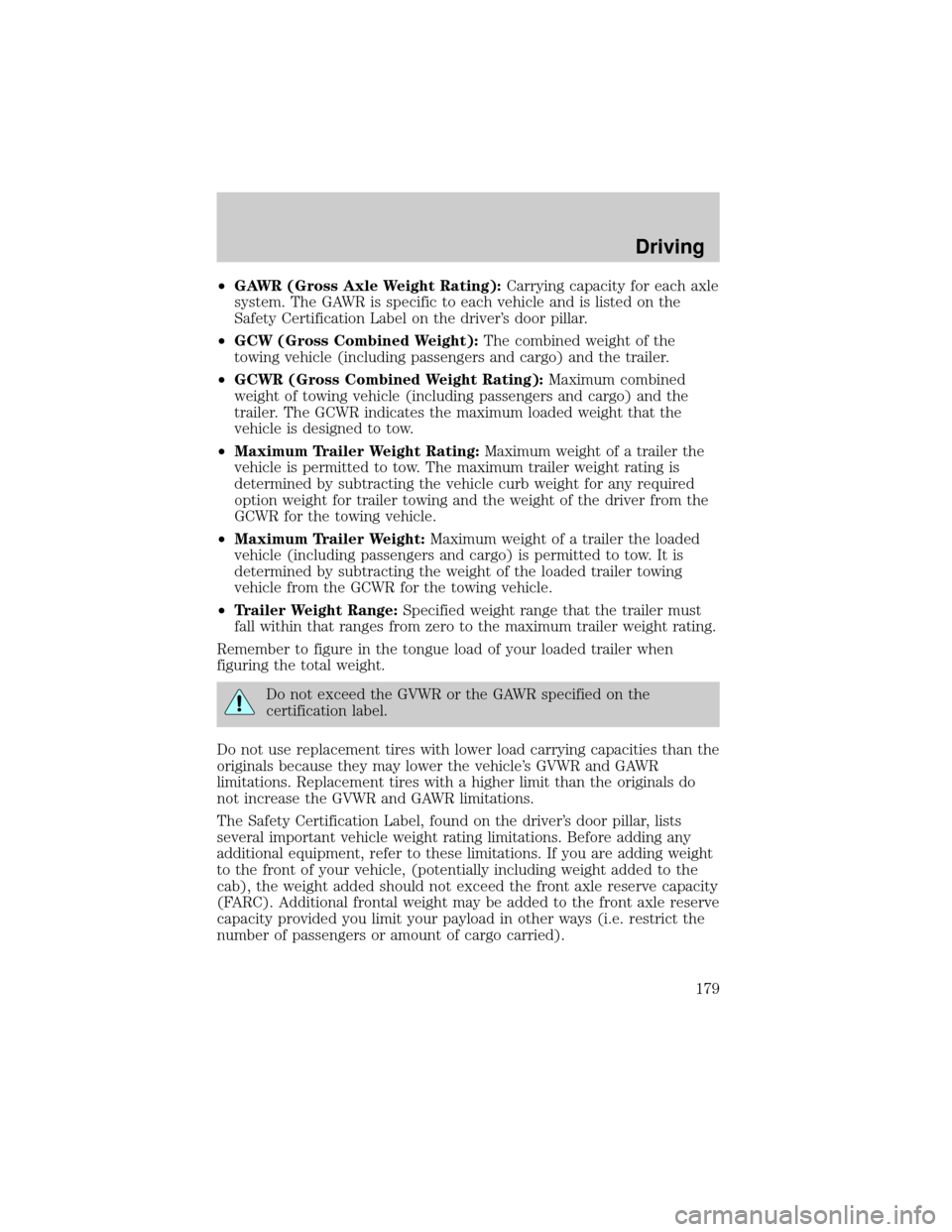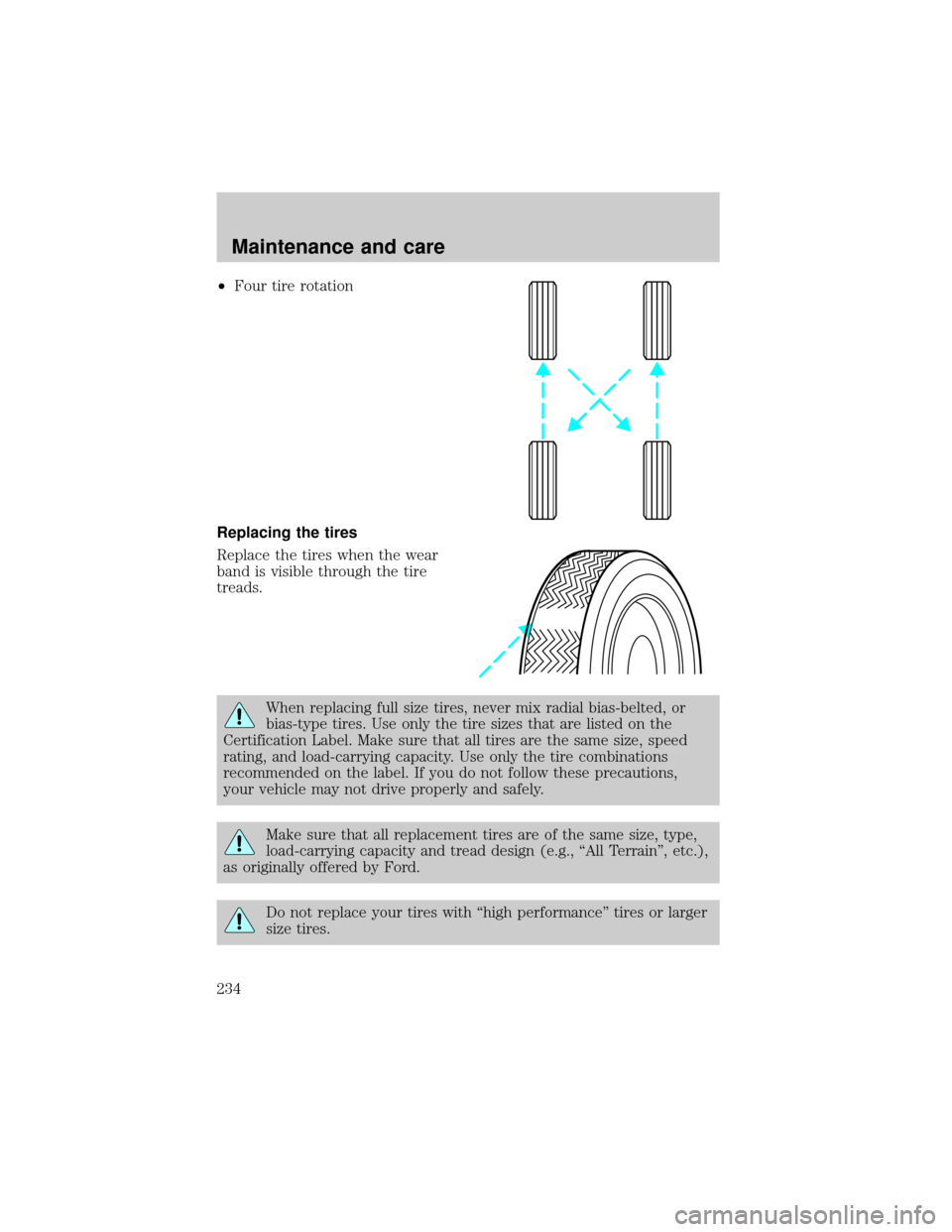load capacity FORD WINDSTAR 2001 2.G Owners Manual
[x] Cancel search | Manufacturer: FORD, Model Year: 2001, Model line: WINDSTAR, Model: FORD WINDSTAR 2001 2.GPages: 288, PDF Size: 2.6 MB
Page 179 of 288

²GAWR (Gross Axle Weight Rating):Carrying capacity for each axle
system. The GAWR is specific to each vehicle and is listed on the
Safety Certification Label on the driver's door pillar.
²GCW (Gross Combined Weight):The combined weight of the
towing vehicle (including passengers and cargo) and the trailer.
²GCWR (Gross Combined Weight Rating):Maximum combined
weight of towing vehicle (including passengers and cargo) and the
trailer. The GCWR indicates the maximum loaded weight that the
vehicle is designed to tow.
²Maximum Trailer Weight Rating:Maximum weight of a trailer the
vehicle is permitted to tow. The maximum trailer weight rating is
determined by subtracting the vehicle curb weight for any required
option weight for trailer towing and the weight of the driver from the
GCWR for the towing vehicle.
²Maximum Trailer Weight:Maximum weight of a trailer the loaded
vehicle (including passengers and cargo) is permitted to tow. It is
determined by subtracting the weight of the loaded trailer towing
vehicle from the GCWR for the towing vehicle.
²Trailer Weight Range:Specified weight range that the trailer must
fall within that ranges from zero to the maximum trailer weight rating.
Remember to figure in the tongue load of your loaded trailer when
figuring the total weight.
Do not exceed the GVWR or the GAWR specified on the
certification label.
Do not use replacement tires with lower load carrying capacities than the
originals because they may lower the vehicle's GVWR and GAWR
limitations. Replacement tires with a higher limit than the originals do
not increase the GVWR and GAWR limitations.
The Safety Certification Label, found on the driver's door pillar, lists
several important vehicle weight rating limitations. Before adding any
additional equipment, refer to these limitations. If you are adding weight
to the front of your vehicle, (potentially including weight added to the
cab), the weight added should not exceed the front axle reserve capacity
(FARC). Additional frontal weight may be added to the front axle reserve
capacity provided you limit your payload in other ways (i.e. restrict the
number of passengers or amount of cargo carried).
Driving
179
Page 234 of 288

²Four tire rotation
Replacing the tires
Replace the tires when the wear
band is visible through the tire
treads.
When replacing full size tires, never mix radial bias-belted, or
bias-type tires. Use only the tire sizes that are listed on the
Certification Label. Make sure that all tires are the same size, speed
rating, and load-carrying capacity. Use only the tire combinations
recommended on the label. If you do not follow these precautions,
your vehicle may not drive properly and safely.
Make sure that all replacement tires are of the same size, type,
load-carrying capacity and tread design (e.g., ªAll Terrainº, etc.),
as originally offered by Ford.
Do not replace your tires with ªhigh performanceº tires or larger
size tires.
Maintenance and care
234
Page 241 of 288

amount of fuel in a full tank and a tank when the fuel gauge indicates
empty. Empty reserve is the small amount of fuel remaining in the fuel
tank after the fuel gauge indicates empty.
The amount of usable fuel in the empty reserve varies and should
not be relied upon to increase driving range. When refueling your
vehicle after the fuel gauge indicates empty, you might not be
able to refuel the full amount of the advertised capacity of the
fuel tank due to the empty reserve still present in the tank.
For consistent results when filling the fuel tank:
²Turn the engine/ignition switch to the off position prior to refueling,
an error in the reading will result if the engine is left running.
²Use the same filling rate setting (low Ð medium Ð high) each time
the tank is filled.
²Allow no more than 2 automatic click-offs when filling.
²Always use fuel with the recommended octane rating.
²Use a known quality gasoline, preferably a national brand.
²Use the same side of the same pump and have the vehicle facing the
same direction each time you fill up.
²Have the vehicle loading and distribution the same every time.
Your results will be most accurate if your filling method is consistent.
Calculating fuel economy
1. Fill the fuel tank completely and record the initial odometer reading
(in kilometers or miles).
2. Each time you fill the tank, record the amount of fuel added (in liters
or gallons).
3. After at least three to five tank fill-ups, fill the fuel tank and record
the current odometer reading.
4. Subtract your initial odometer reading from the current odometer
reading.
5. Follow one of the simple calculations in order to determine fuel
economy:
Multiply liters used by 100, then divide by total kilometers
traveled.
Divide total miles traveled by total gallons used.
Maintenance and care
241
Page 280 of 288

lubrication
specifications ..................259, 261
refill capacities ........................258
service points ..........................210
starting after a collision .........186
Engine block heater .................165
Engine oil ..................................211
change oil soon warning,
message center .......................211
checking and adding ..............211
dipstick ....................................211
filter, specifications ........213, 257
recommendations ...................213
refill capacities ........................258
specifications ..................259, 261
Exhaust fumes ..........................166
F
Floor mats .................................101
Fluid capacities .........................258
Fuel ............................................236
calculating
fuel economy ....................25, 240
cap .....................................12, 238
capacity ...................................258
choosing the right fuel ...........238
comparisons with EPA fuel
economy estimates .................243
detergent in fuel .....................240
filling your vehicle
with fuel ..................236, 238, 240
filter, specifications ........240, 257
fuel pump shut-off switch .....186
gauge .........................................15
improving fuel economy ........240
low fuel warning light ................8
octane rating ...................239, 261
quality ......................................239
running out of fuel .................240safety information relating
to automotive fuels ................236
Fuses ..................................187±188
G
Garage door opener ..............90, 97
Gas cap (see Fuel cap) ......12, 238
Gas mileage
(see Fuel economy) .................240
Gauges .........................................14
engine coolant temperature
gauge .........................................16
fuel gauge ..................................15
odometer ...................................16
speedometer .............................15
tachometer ................................15
trip odometer ............................16
GAWR
(Gross Axle Weight Rating) .....178
calculating ...............................180
definition .................................178
driving with a heavy load ......178
location ....................................178
GVWR (Gross
Vehicle Weight Rating) .............178
calculating .......................178, 180
definition .................................178
driving with a heavy load ......178
location ....................................178
H
Hazard flashers .........................186
Head restraints .................119, 122
Headlamps ...................................27
aiming ..............................250±251
autolamp system .......................29
bulb specifications ..................250
Index
280
Page 282 of 288

Load limits .................................178
GAWR ......................................178
GVWR ......................................178
trailer towing ..........................178
Locks
autolock ...................................110
childproof ..................................88
Lubricant specifications ...259, 261
Lumbar support, seats .............122
M
Message center ...........................17
english/metric button ...............18
system check button ................18
warning messages .....................19
Mirrors .........................................90
automatic dimming rearview
mirror ........................................89
cleaning ...................................254
fold away ...................................87
heated ........................................87
programmable memory ..........109
side view mirrors (power) .......86
Motorcraft parts ................240, 257
O
Octane rating ............................239
Odometer .....................................16
Oil (see Engine oil) ..................211
Overdrive .............................83, 174
P
Panic alarm feature,
remote entry system ................106
Parking brake ............................168Parts (see Motorcraft parts) ....257
Passenger Occupant
Classification Sensor .................132
Pedals (see Power
adjustable foot pedals) ...............78
Power adjustable foot pedals .....78
Power distribution box
(see Fuses) ...............................192
Power door locks ................88, 110
Power steering ..........................173
fluid, checking and adding ....221
fluid, refill capacity ................258
fluid, specifications .........259, 261
R
Radio ............................................39
Relays ........................................187
Remote entry system .......102, 106
illuminated entry ......28, 107, 110
locking/
unlocking doors ..............103±105
panic alarm .............................106
replacement/additional
transmitters .............................108
replacing the batteries ...........107
Reverse sensing system .............75
Roof rack ...................................184
S
Safety belts (see Safety
restraints) ....14, 131, 134±137, 139
Safety defects, reporting ..........277
Safety
restraints ...........131, 134±137, 139
belt minder .............................140
Index
282